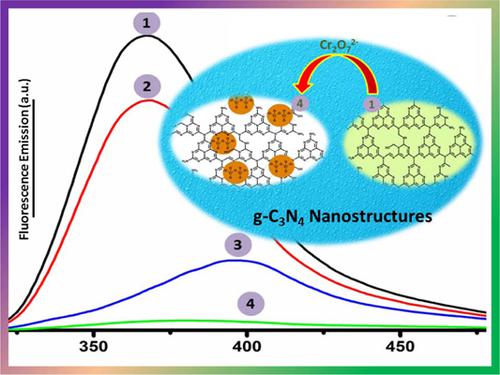Current Analytical Chemistry ( IF 1.7 ) Pub Date : 2020-07-31 , DOI: 10.2174/1573411014666180627150248 Ghasem Shiravand 1 , Alireza Badiei 1 , Hassan Goldooz 1 , Mehdi Karimi 1 , Ghodsi M. Ziarani 2 , Farnoush Faridbod 3 , Mohammad R. Ganjali 3

|
Background: Dichromate (Cr2O7 2-) ion is one of the carcinogenic and toxic spices in environment which can easily contaminate the environment due to its high solubility in water. Therefore, a lot of attention has been focused on the detection of Cr2O7 2- with high sensitivity and selectivity.
Methods: In present work, nitrogen-rich precursor was used for synthesizing graphitic carbon nitride (g-C3N4) nanostructures through hydrothermal oxidation of g-C3N4 nanosheets. The prepared nanostructures show two distinct fluorescence emissions centered at 368 and 450 nm which are highly sensitive toward Cr2O7 2- ions.
Results: The as-prepared g-C3N4 was characterized by several techniques such as Fourier-Transform Infrared Spectroscopy (FTIR), Scanning Electron Microscopy (SEM), X-ray Diffraction (XRD) and fluorescence emission spectra. The XRD pattern of prepared nanostructures illustrated two diffraction patterns (at 13.4° and 27.6°) indicating tri-s-tri-azine-based structures. The g-C3N4 exhibited good selectivity and sensitivity toward Cr2O7 2- among other anions. According to titration test, the detection limit and stern-volmer constant (Ksv) were calculated as 40 nM and 0.13×106 M-1, respectively. The investigation of quenching mechanism shows that Cr2O7 2- may form hydrogen bonding with surface groups of g-C3N4 (such as NH2, OH and COOH) resulted in more fluorescence quenching in comparison with the pure inner filter effect.
Conclusion: The g-C3N4 nanostructures were successfully synthesized through the hydrothermal oxidation. The as-prepared g-C3N4 can be used as a highly sensitive fluorescent probe for the selective determination of Cr2O7 2 ion among other anions. The quenching mechanism was experimentally studied. According to reliable responses in real sample tests, it can be proposed that g-C3N4 nanostructure is a suitable sensitive nanosensor for detection of Cr2O7 2 ions in aqueous media.
中文翻译:

用于检测重铬酸盐离子的荧光g-C3N4纳米传感器
背景:重铬酸根(Cr2O7 2-)离子是环境中的一种致癌和有毒的香料,由于其在水中的高度溶解性,很容易污染环境。因此,在高灵敏度和高选择性的Cr 2 O 7 2-的检测上已经引起了很多关注。
方法:在目前的工作中,使用富氮前体通过水热氧化g-C3N4纳米片来合成石墨氮化碳(g-C3N4)纳米结构。制备的纳米结构显示出两个分别在368和450 nm处集中的荧光发射,这些荧光发射对Cr2O7 2-离子高度敏感。
结果:制备的g-C3N4通过几种技术进行了表征,例如傅立叶变换红外光谱(FTIR),扫描电子显微镜(SEM),X射线衍射(XRD)和荧光发射光谱。制备的纳米结构的XRD图谱显示了两个衍射图谱(在13.4°和27.6°),表明基于三-s-三嗪的结构。除其他阴离子外,g-C3N4对Cr2O7 2-表现出良好的选择性和敏感性。根据滴定测试,检出限为40 nM,船尾体积常数(Ksv)为0.13×106 M-1。猝灭机理的研究表明,与纯内部滤光效果相比,Cr2O7 2-可能与g-C3N4的表面基团(如NH2,OH和COOH)形成氢键,从而导致更多的荧光猝灭。
结论:通过水热氧化成功地合成了g-C3N4纳米结构。所制备的g-C3N4可用作高灵敏度的荧光探针,用于选择性测定Cr2O7 2离子以及其他阴离子。实验研究了淬灭机理。根据实际样品测试中的可靠响应,可以提出g-C3N4纳米结构是用于检测水性介质中Cr2O7 2离子的合适灵敏纳米传感器。











































 京公网安备 11010802027423号
京公网安备 11010802027423号